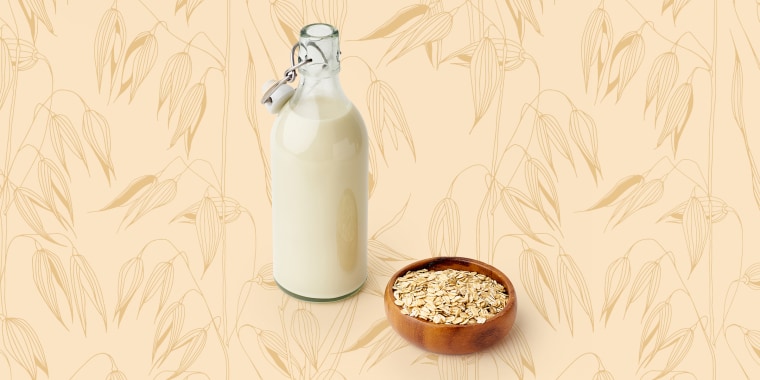When you head to the dairy aisle these days, you’re faced with a dizzying selection of non-dairy milk options (or mylks). In addition to the more familiar almond, soy, and coconut milks, you’ll also see plenty of options from a certain grain that you usually find in your breakfast bowl — oats. In fact, oat milk is the second most popular plant milk now, right behind almond milk, racking up over $249 million in sales last year.
So, what exactly is oat milk?
The Swedish brand Oatly was the first oat milk to enter the U.S. market back in 2016 and has seen huge growth ever since. Other brands, like Califia, Planet Oat, Chobani and Danone followed suit with their own offerings.
Homemade oat milk is made by soaking steel cut oats in water, blending them into a mush, and then pouring the mixture through a fine mesh sieve or cheesecloth. Once you have the liquid, you can flavor it with vanilla or cinnamon and add sweetener if you like. Most brands make their oat milk by creating an oat concentrate or base, and then blending that back with water. To that they add either canola (rapeseed) or sunflower oil, salt, calcium (as calcium phosphate or calcium carbonate), and various vitamins. Some brands also add thickeners and emulsifiers, such as lecithin, gellan gum, gum acacia and locust bean gum. Depending on the flavor, sugar may also be added to the mix. There are a few brands, like Elmhurst, with minimal added ingredients.
Part of oat milk’s popularity is the fact that oats are low in allergens, which means that most people can enjoy it, unlike soy and nut milks. Also, oat milk has a creamy consistency in comparison to other plant milks, which can be on the thin side, making it a top choice for baristas and coffee lovers. The sustainable nature of oats, versus almonds or cashews, has also contributed to oat milk’s popularity among eco-conscious millennials. Additionally, the growing interest in vegan diets has made oat beverages a top choice for many consumers.
How nutritious is oat milk?
Nutrition varies from brand to brand, but on average, an 8-ounce glass of unsweetened oat milk has 120 calories, 5g fat, 3g protein, 16g of carbohydrates, 1g of fiber and 350 mg of calcium. When compared to other plant milks, like almond, coconut or cashew, it’s higher in calories and carbohydrates. Compared to whole cow’s milk, oat milk has about 30 fewer calories and less protein and fat.
What to look for when shopping for oat milk
You’ll see many brands of oat milk in the refrigerated section of the grocery store, but a few, like Elmhurst and Pacific Foods, offer shelf-stable versions. Both should be refrigerated after opening, just like regular milk. Make sure to follow the directions on the package for how long you can use the product once you've opened it.
While plain, unsweetened oat milk usually has just 4g of sugar per serving, the chocolate versions can have up to 12g of added sugar per serving, which also makes them higher in calories. Plain oat milk tastes naturally sweet because the complex carbohydrates in the oats are broken down into simple sugars during the production process. This is why some plain versions with no extra sugar have to list added sugars on the Nutrition Facts label. For the healthiest pick, stick to the unsweetened versions.
Most brands offer an original line, as well as a “barista” line of oat milk. The barista versions have a slightly higher fat content and are formulated specifically to foam, steam and blend into coffee beverages. Even with the rise of organic food products, there aren’t many USDA organic oat milks yet. But smaller brands, like Willa’s, are making a name for themselves in the organic sector with people looking for pesticide-free options.
If you need to follow a gluten-free diet, oat milk may not be the best choice. While oats don’t contain gluten, many oat products are processed in facilities that process gluten-containing products, which means there could be traces of gluten in the oat milk. Some brands, including Planet Oat and Oatly, are gluten-free. And you can always make your own gluten-free version by using certified gluten-free oats.
Need to avoid oil? Look for low-fat options, like one from Oatly, that offers a version of their oat milk without the oil, which also brings the calories down. There is still some fat in the product from the oats themselves.
How to use oat milk
Oat milk can be used in cooking and baking in the same amounts you’d use regular milk or other milk alternatives. Because oat milk has a naturally sweet taste, it works really well in baked goods, pancakes and waffles, smoothies, milk shakes, and warm drinks, but may not be the best choice for a savory cream-based soup.
If like millions of other Americans, you’re an oat milk fan, you can also find oat milk yogurt, coffee creamer and ice cream. And if Oatly’s European offerings are any indication of the future of oat milk products here, we may be seeing oaty versions of cream cheese, spreads and heavy cream very soon.




